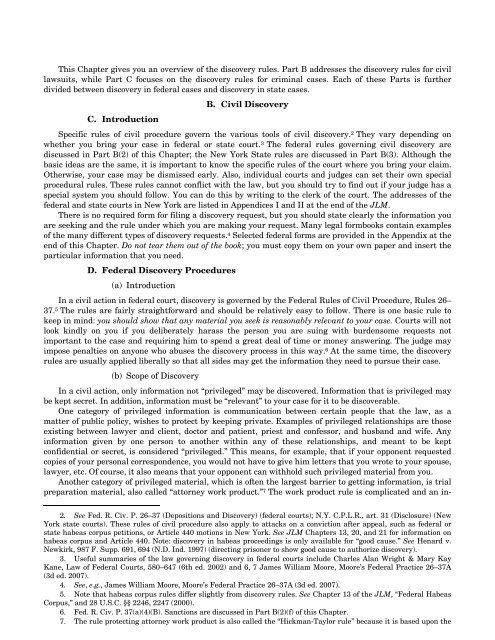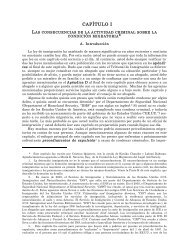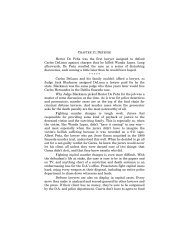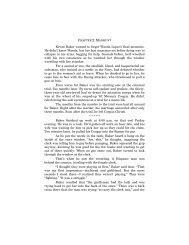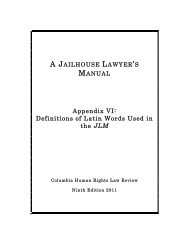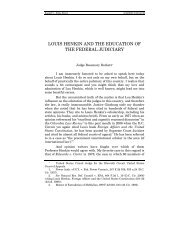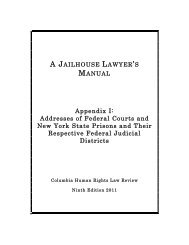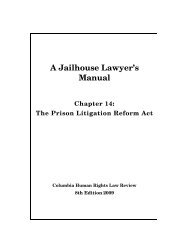A Jailhouse Lawyer's Manual - Columbia Law School
A Jailhouse Lawyer's Manual - Columbia Law School
A Jailhouse Lawyer's Manual - Columbia Law School
You also want an ePaper? Increase the reach of your titles
YUMPU automatically turns print PDFs into web optimized ePapers that Google loves.
This Chapter gives you an overview of the discovery rules. Part B addresses the discovery rules for civil<br />
lawsuits, while Part C focuses on the discovery rules for criminal cases. Each of these Parts is further<br />
divided between discovery in federal cases and discovery in state cases.<br />
C. Introduction<br />
B. Civil Discovery<br />
Specific rules of civil procedure govern the various tools of civil discovery. 2 They vary depending on<br />
whether you bring your case in federal or state court. 3 The federal rules governing civil discovery are<br />
discussed in Part B(2) of this Chapter; the New York State rules are discussed in Part B(3). Although the<br />
basic ideas are the same, it is important to know the specific rules of the court where you bring your claim.<br />
Otherwise, your case may be dismissed early. Also, individual courts and judges can set their own special<br />
procedural rules. These rules cannot conflict with the law, but you should try to find out if your judge has a<br />
special system you should follow. You can do this by writing to the clerk of the court. The addresses of the<br />
federal and state courts in New York are listed in Appendices I and II at the end of the JLM.<br />
There is no required form for filing a discovery request, but you should state clearly the information you<br />
are seeking and the rule under which you are making your request. Many legal formbooks contain examples<br />
of the many different types of discovery requests. 4 Selected federal forms are provided in the Appendix at the<br />
end of this Chapter. Do not tear them out of the book; you must copy them on your own paper and insert the<br />
particular information that you need.<br />
D. Federal Discovery Procedures<br />
(a) Introduction<br />
In a civil action in federal court, discovery is governed by the Federal Rules of Civil Procedure, Rules 26–<br />
37. 5 The rules are fairly straightforward and should be relatively easy to follow. There is one basic rule to<br />
keep in mind: you should show that any material you seek is reasonably relevant to your case. Courts will not<br />
look kindly on you if you deliberately harass the person you are suing with burdensome requests not<br />
important to the case and requiring him to spend a great deal of time or money answering. The judge may<br />
impose penalties on anyone who abuses the discovery process in this way. 6 At the same time, the discovery<br />
rules are usually applied liberally so that all sides may get the information they need to pursue their case.<br />
(b) Scope of Discovery<br />
In a civil action, only information not “privileged” may be discovered. Information that is privileged may<br />
be kept secret. In addition, information must be “relevant” to your case for it to be discoverable.<br />
One category of privileged information is communication between certain people that the law, as a<br />
matter of public policy, wishes to protect by keeping private. Examples of privileged relationships are those<br />
existing between lawyer and client, doctor and patient, priest and confessor, and husband and wife. Any<br />
information given by one person to another within any of these relationships, and meant to be kept<br />
confidential or secret, is considered “privileged.” This means, for example, that if your opponent requested<br />
copies of your personal correspondence, you would not have to give him letters that you wrote to your spouse,<br />
lawyer, etc. Of course, it also means that your opponent can withhold such privileged material from you.<br />
Another category of privileged material, which is often the largest barrier to getting information, is trial<br />
preparation material, also called “attorney work product.” 7 The work product rule is complicated and an in-<br />
2. See Fed. R. Civ. P. 26–37 (Depositions and Discovery) (federal courts); N.Y. C.P.L.R., art. 31 (Disclosure) (New<br />
York state courts). These rules of civil procedure also apply to attacks on a conviction after appeal, such as federal or<br />
state habeas corpus petitions, or Article 440 motions in New York. See JLM Chapters 13, 20, and 21 for information on<br />
habeas corpus and Article 440. Note: discovery in habeas proceedings is only available for “good cause.” See Henard v.<br />
Newkirk, 987 F. Supp. 691, 694 (N.D. Ind. 1997) (directing prisoner to show good cause to authorize discovery).<br />
3. Useful summaries of the law governing discovery in federal courts include Charles Alan Wright & Mary Kay<br />
Kane, <strong>Law</strong> of Federal Courts, 580–647 (6th ed. 2002) and 6, 7 James William Moore, Moore’s Federal Practice 26–37A<br />
(3d ed. 2007).<br />
4. See, e.g., James William Moore, Moore’s Federal Practice 26–37A (3d ed. 2007).<br />
5. Note that habeas corpus rules differ slightly from discovery rules. See Chapter 13 of the JLM, “Federal Habeas<br />
Corpus,” and 28 U.S.C. §§ 2246, 2247 (2000).<br />
6. Fed. R. Civ. P. 37(a)(4)(B). Sanctions are discussed in Part B(2)(f) of this Chapter.<br />
7. The rule protecting attorney work product is also called the “Hickman-Taylor rule” because it is based upon the


